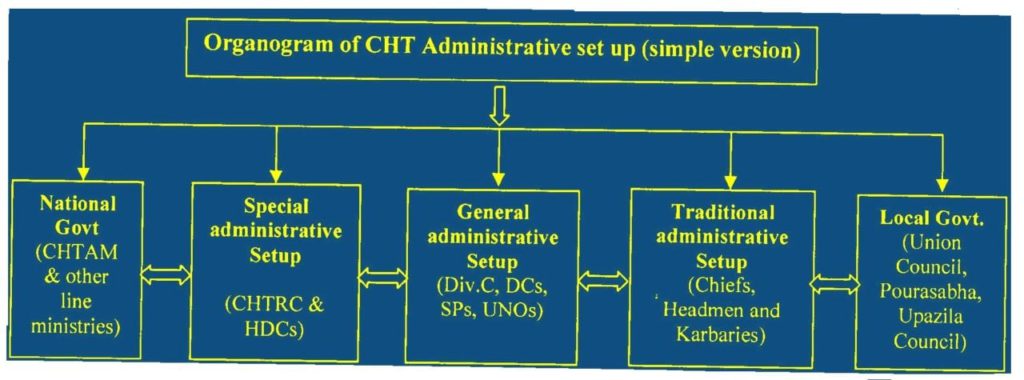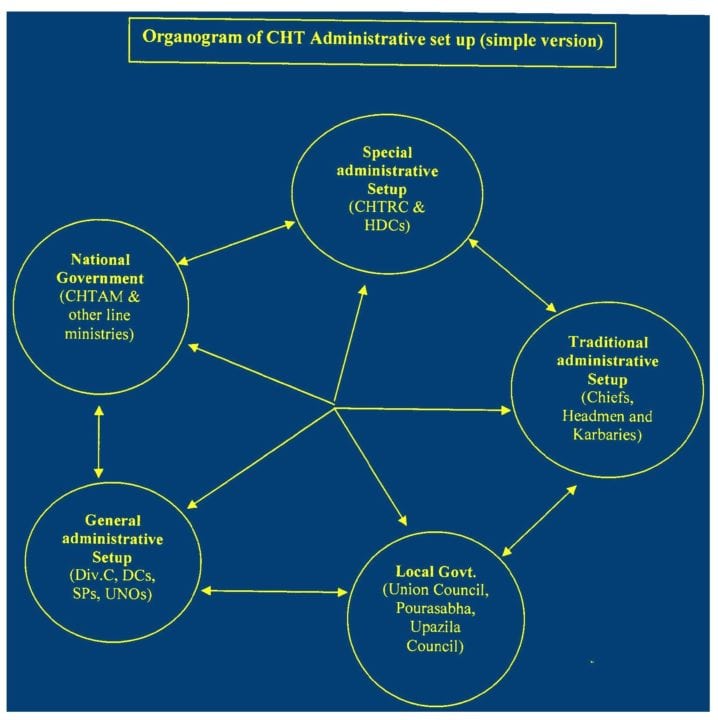Introduction:
Before the British colonization, the vast area even beyond the present CHT region was an independent kingdom. During the whole period of the Mughal rule in this Indian sub-continent, the Chakma Kings were internally supreme and externally free. In 1550 a Portuguese cartographer named Joa De Barros shown the Chakma kingdom on his map marking its boundary with the Feni River on the North, the Namre or Naf River on the south, the Lushai hills on the east and sea on the west.
In 1763 Mr. Henry Verlest, the First Chief Officer of the Chittagong Council appointed by the East India Company officially proclaimed that the ‘tract’ bounded by the Nizampur road, Kuki territory, the Feni, and Sangu rivers belonged to the Chakma Raja.
There had been no external interference by any outside power in the affairs of the CHT until 1787 when an agreement was signed with the British and the British colonization started since 1860. So the Kings of the CHT reigned independently during the whole pre-British Era.
During the British Period, the local administration of CHT was different from the other many areas of India sub-continent. The British has enacted the CHT Regulation in 1900. The Regulation is also known as “CHT Manual” or “1900 Regulation.” The nature of the Regulation is like a constitution.
This period witnessed CHT have enjoyed the “excluded area” status (under Provisional India Act of 1935) with “inner line regulation,” (CHT Manual) for protection of the Indigenous people from the outsiders of CHT, under the direct control of Bengal Governor through the Deputy Commissioner.
After partition, Islamic Republic of Pakistan initially retained the ‘Excluded Area’ status of the CHT constitutionally and subsequently, this status was renamed as ‘Tribal Area’ in the constitution. In later years, the successive governments of Pakistan annulled the ‘Inner Line Regulation’ and brought in drastic changes to the CHT Regulation 1900 directing to the removal of the legal bar to having access to CHT for the outsiders from plains. Thus, how the CHT Regulation 1900 was weakened by the successive governments of Pakistan and Bangladesh after independence. During the period of Pakistan the Deputy Commissioners, violating Section-38 and 39 of the CHT Regulation 1900, totally ignored obligation of consultations with the Advisory Council formed by the Circle Chiefs and convening Chiefs’ Conference. Further amendments to the Regulation have established the supremacy of Deputy Commissioner while reducing the powers of traditional institutions of Chieftainships.
In this circumstance, CHT Accord 1997 has been a revolutionary step to turn Bangladesh into a democratic institution attuned with the global advancement of human civilization. The text in the Accord began with a vow to ensure the tribal-dominating feature of CHT as it has always been in the past. It is an effective mechanism by dint of which a special administrative system with a structure comprising of Ministry of CHT Affairs, Regional Council and three Hill District Councils has been introduced to CHT. This provision in recognition to the rights of indigenous peoples of CHT is a bottom-up pressure upon the civic polity of Bangladesh to wriggle out from the grip of unitary government mania. But non-implementation of the Accord associated with anti-accord posture being maintained by the civic polity in the successive governments has already landed the country in a fresh trouble that could invite another disastrous outcome in the national life.
CHT under the National Government set-up:
As per the Accord, the Ministry of CHT Affairs (MoCHTA) with a full-pledged Minister from among the indigenous peoples constitutes a part of the Cabinet in the government. MoCHTA mainly deals with the issues relating to CHT, apart from its routine responsibilities as part of the government.
The government machinery also includes Divisional Commissioner at Division level and Deputy Commissioner and Superintendent of Police at the district level. Besides, there are also Executive Officers called Nirbahi Officers at Upazila (Sub-division) level. These administrative layers discharge their functions under the Ministry of Establishment and other line ministries.
Since hitherto no Regulations for making the existing laws functional to their scope of jurisdictions have been formulated. Hence, administratively CHT suffers from chaos and confusion due to the existence of conflicts and over-lapping of legal aspects lying with the earlier and later introduced laws existing in CHT. This phenomenon, instead of being inclusive, makes the laws negate one another in most cases often paralyzing the whole governance system.
In addition, on top of all, there is military supremacy in the governance system in CHT. The military with its one-tenth strength of total forces stationed in CHT is empowered under special mandate officially known as ‘Operation Uttoran’ (Operation Upliftment). This has contributed the governance system in CHT to a cocktail administration, which may better be attributed to being a covert military rule.
Special Administrative System:
In the context of historical reality in perspectives of economic, social, cultural, geographic and political distinctness of indigenous Jumma peoples from the majority population of Bangladesh, the provisions defined in the CHT Accord 1997 provide the only way to establish perennial peace in the region. Accordingly, there has been established a special administrative system with MoCHTA, CHT Regional Council (CHTRC) and three Hill District Councils (HDCs). Though there have been sharp contentions of differences between the government and regional council, respective laws for the councils though have been formulated and introduced but these laws are yet to be made functional to their fullest by formulating regulations while repelling the conflicting sections of the other existing laws to make them compatible to the later laws.
-
- (a)
MoCHTA:
- MoCHTA is governed by a set of Rules defined by the government. As per the Accord, MoCHTA is supposed to be a full-pledged Ministry with a full-pledged Minister from among the CHT tribal peoples. But up till this day, the ministry is being looked after by a State Minister under the direct control of the Prime Minister.
-
- (b)
CHTRC:
- As per the act, CHTRC is comprised of 22 members with 2/3 indigenous representation including its Chairperson. Seven seats are reserved for non-indigenous persons and three for women (2 indigenous and 1 non-indigenous). The Regional Council is to be elected by the three Hill District Councils and from among the permanent residents of CHT for a five-year term. The Chairmen of three HDCs are also ex-officio members of the CHTRC.
The CHT Regional Council is an apex body of the CHT administrative setup, which has been introduced to make CHT a unique political and administrative unit. The primary functions of the Regional Council include, among others, supervision and coordination of the development activities and other functions of the HDCs disposed under the subjects transferred to the three HDCs, law, and order, general administrations, development, CHT Development Board, traditional and social justice etc. including the authority of issuing license for heavy industries. CHTRC is also mandated with the legal bindings of being pre-informed and consulted with, in cases where the government intends to make laws or goes for any program relating to CHT.
(c) Hill District Council:
In 1989, three Hill District Local Government Councils namely, Bandarban Hill District Local Government Council, Rangamati Hill District Local Government Council, and Khagrachari Hill District Local Government Council were established in CHT. Later on, these councils were re-organized and renamed as Bandarban Hill District Council, Rangamati Hill District Council and Khagrachari Hill District Council as per the Accord. Amendment was brought in the three Hill District Council Act(s) in 1998.
HDC is an elected body and consisted of 34 members representing most of the ethnic communities including 10 from the non-indigenous origin and 3 seats for women with Chairman of the council mandatorily from the ethnic indigenous groups. In order to let the councils be started with, 5-member councils were formed as an Interim Council for all the three hill districts.
As per the Accord and the Hill District Council Act, the HDCs are to be transferred with 33 subjects including overall co-ordination, maintenance, and improvement of the law and order of the district; control over the police administration of the district; land and land management, agriculture, primary and secondary education, youth welfare, justice related to the tribal affairs, according to the customs, culture of the tribal people; and co-ordination of the development activities of the local authorities, environmental protection and development, local tourism etc. of the district monitoring the implementation of its development projects and audit thereof, rendering assistance, cooperation and encouragement etc with several other subjects.
However, up till this day, no election for the Hill District Councils has held. In the meanwhile, the Hill Councils have got overloaded with burdens of work and suffered from human resources at all fronts. Now the government, instead of holding elections, has passed a bill to increase the number of members for the interim councils and issued an order to send in opinions of the Hill District Councils within prescribed limit regarding the increase of the members up to 15. This move on the part of government proves to be bankruptcy at the policy level.
Traditional Institutions:
- The traditional institutions in CHT, ever since the commencement of colonization, have been dealing with the issues such as lands of traditional usages, social justice, customs, rites, and rituals. The traditional administrative setup comprises Circle Chieftainship, Headmanship, and Karbariship at the grass root level.
Traditionally and as already established with CHT Regulation 1900, the CHT was divided into three Circles, namely Chakma Circle, Bohmang Circle and Mong Circle – each circle is headed by a Circle Chief. Again, each circle is divided into several smaller administrative units called Mouzas, which are comprised of some villages. Each Mouza is headed by an administrative head, called Headman. Under a Mouza, there are several villages and head of the village is called Karbari. Till today, this system is recognized by the government of Bangladesh.
The post of the Circle Chief is hereditary, as is (was) the case with Headmen. Generally, the child of past Headman is given priority for headship. Both the Circle Chiefs and the Headmen used to discharge their duties and functions according to customs and traditions (partially recognized by the CHT Regulation of 1900 enacted by the then British government). Among the important duties and responsibilities of the Headmen are – the collection of land tax, providing the recommendation for distribution and settlement of land, maintenance of land records, preservation and maintenance of community forest resources and settlement of social disputes in accordance with the indigenous peoples’ customary laws. The responsibility of land settlement and land management is primarily vested with Headmen. Thus, proper management and control of the above issues depended on the respective Headman’s capacity and efficiency.
Along with the passage of time the traditional institutions have been more and more weakened in this way. These are now in a moribund condition yet the successive Governments could not abolish these totally. However, after a long gap, 1997 the Parbatya Chattagram Jana Samhati Samiti (PCJSS) and the Bangladesh Government signed the historic CHT Accord with provisions for the amalgamation of the traditional Raja-Headman-Karbari administrative system with the democratic institutions for better and meaningful role. The CHT Accord 1997, the Hill District Council Acts of 1998 and the CHT Regional Council Act, 1998 have a good number of provisions to this end. Clause 19 of part D of the Accord gives the Circle Chiefs access to the Ministry of CHT Affairs (MoCHTA) as members of the Advisory Committee to assist the Ministry and clause 12 of part B of the Accord authorizes them to join the Hill District Councils’ (HDCs) meetings.
In this way, the traditional institutions such as the offices of Raja-Headman-Karbari have been integrated into the democratic institutions like the MoCHTA, CHTRC, and HDCs. This involvement has opened up a scope to get the traditional system involved in the development sector.
Other local governance bodies:
There are the local government councils, such as, Union Councils, Municipalities and Upazila Councils who look after the development activities in their respective areas. Though these local government councils discharge their duties under the Local Government Ministry in one hand and under the supervision and coordination of CHTRC and HDCs on the other.




